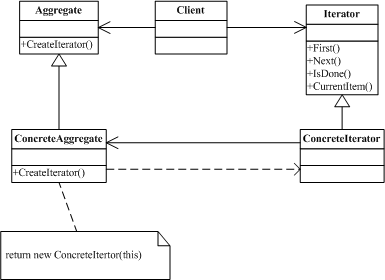何为迭代器模式?
迭代器提供了一种顺序访问集合对象中元素的方法,而无需暴漏结构的底层表示和细节。遍历集合中元素的职能从集合本身转移到迭代器对象。迭代器定义了一个用于访问集合元素并记录当前元素的接口。不同的迭代器可以执行不同的策略。
例子
说了这么多,下面给大家展示一下类关系图。

上图中Client的右边是迭代器,左边是具体迭代的类型,在迭代器内部对具体需要迭代的类型进行了引用,还算不难理解吧,呵呵。其实,看起来是为了对具体类型进行解耦。好啦,下面给出具体的代码实现,简单的模拟了迭代器模式。
注意:本文所有代码均在ARC环境下编译通过。
Iterator类接口
复制代码 代码如下:
#import <Foundation/Foundation.h>
@interface Iterator:NSObject
-(id)First;
-(id)Next;
-(BOOL)IsDone;
-(id)CurrentItem;
@end
Iterator类实现
复制代码 代码如下:
#import "Iterator.h"
@implementation Iterator
-(id)First{
return nil;
}
-(id)Next{
return nil;
}
-(BOOL)IsDone{
return NO;
}
-(id)CurrentItem{
return nil;
}
@end
ConcreteIterator类接口
复制代码 代码如下:
#import "Iterator.h"
@class ConcreteAggregate;
@interface ConcreteIterator :Iterator{
ConcreteAggregate *myAggregate;
int current;
}
-(ConcreteIterator*)MyInit:(ConcreteAggregate*)aggregate;
@end
ConcreteIterator类实现
复制代码 代码如下:
#import "ConcreteIterator.h"
#import "ConcreteAggregate.h"
@implementation ConcreteIterator
-(ConcreteIterator*)MyInit:(ConcreteAggregate*)aggregate{
myAggregate = aggregate;
return self;
}
-(id)First{
return [myAggregate GetObject:0];
}
-(id)Next{
current++;
if(current< [myAggregate GetCount])
return [myAggregate GetObject:current];
else {
return nil;
}
}
-(BOOL)IsDone{
return current>= [myAggregate GetCount] ?YES:NO;
}
-(id)CurrentItem{
return [myAggregate GetObject:current];
}
@end
Aggregate类接口
复制代码 代码如下:
#import <Foundation/Foundation.h>
@class Iterator;
@interface Aggregate:NSObject
-(Iterator*)CreateIterator;
@end
Aggregate类实现
复制代码 代码如下:
#import "Aggregate.h"
#import "Iterator.h"
@implementation Aggregate
-(Iterator*)CreateIterator{
return [[Iterator alloc]init];
}
@end
ConcreteAggregate类接口
复制代码 代码如下:
#import "Aggregate.h"
@interface ConcreteAggregate:Aggregate{
NSMutableArray *items;
}
-(int)GetCount;
-(id)GetObject:(int)index;
-(void)InsertObject:(id)Obj;
@end
ConcreteAggregate类实现
复制代码 代码如下:
#import "ConcreteAggregate.h"
#import "Iterator.h"
@implementation ConcreteAggregate
-(id)init{
if(self == [super init]){
items = [NSMutableArray new];
}
return self;
}
-(Iterator*)CreateIterator{
return [[Iterator alloc]init];
}
-(id)GetObject:(int)index{
return [items objectAtIndex:index];
}
-(void)InsertObject:(id)Obj{
[items addObject:Obj];
}
-(int)GetCount{
return [items count];
}
@end
Main方法调用
复制代码 代码如下:
import <Foundation/Foundation.h>
#import "ConcreteAggregate.h"
#import "Iterator.h"
#import "ConcreteIterator.h"
int main (int argc, const char *argv[])
{
@autoreleasepool {
ConcreteAggregate *a = [[ConcreteAggregate alloc]init];
[a InsertObject:@"张三"];
[a InsertObject:@"李四"];
[a InsertObject:@"王二"];
[a InsertObject:@"麻子"];
NSLog(@"Count:%d", [a GetCount]);
Iterator *i = [[ConcreteIterator alloc]MyInit:a];
while (![i IsDone]) {
NSLog(@"%@,请买票",[i CurrentItem]);
[i Next];
}
}
return 0;
}
好啦,上面的四个类型简单实现了迭代器模式,其实迭代器模式就是分离了集合对象的遍历行为,抽象出一个迭代器类来负责,这样既可以做到不暴露集合的内部结构,又可以让外部代码透明地访问集合内部地数据。
何时使用迭代器模式?
1.需要访问组合对象的内容,而又不暴漏其内部表示。
2.需要通过多种方式遍历组合对象。
3.需要提供一个统一的接口,用来遍历各种类型的组合对象。
【iOS App设计模式开发中对迭代器模式的使用示例】相关文章:
★ iOS开发中Quartz2D绘图路径的使用以及条纹效果的实现
★ iOS App开发中Masonry布局框架的基本用法解析
★ iOS App设计模式开发中对interpreter解释器模式的运用
★ iOS开发中UITabBarController的使用示例
